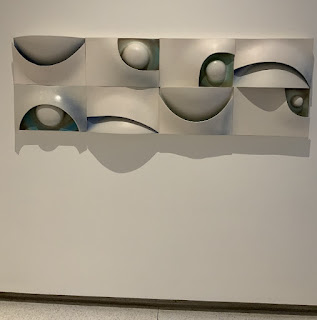A review of "Ruth Duckworth: Life as Unity" at the Smart Museum
Sometime in the mid sixties - around the time when the first full-disc photos of our planet were being published - Ruth Duckworth (1919-2009) had an epiphany: "I think of life as a unity. This includes mountains, mice, rocks, trees, women, and men. It's all one big lump of clay. I think of life as a unity."
It was soon commemorated by "Earth, Water, Sky" (1967-1968), a room-sized, permanent installation commissioned for the newly built Harry Hinds Laboratory for Geophysical Sciences at the University of Chicago.
Only the maquette could be included in this show but you can already feel the inner power of our wonderful planet.
It’s constituent elements (earth, water, sky) are represented by the smaller ceramics included in this show. She has fashioned clay into aerodynamic birds, round heavy pots, and watery flowing waves. All of these pieces are pleasant and imaginative, running the gamut of ceramic technique. But none of them appear to be seeking the transformative, volcanic power of her immersive installation two blocks south on Ellis Avenue. Nor do they have the formal intensity that traditional potters can summon for the simple shapes of a cup or bowl. Her pieces are more like a personal journey through the academic trends that coincided with her life. They do not feel psychological - like the work of her more famous contemporary, Lee Bontecou. Duckworth looks outward, not inward.
There’s the machine aesthetic of British modernist sculpture; the down-to-earth organics of environmentalism; and the provocation of feminism. A perforated tube that might suggest an alien space station is juxtaposed with a severely elegant bird form and a somewhat scary eruption of female genitalia. Then there are the serene, watery pieces that belong in the lobby of a hotel or airport waiting room.
Duckworth retired from the University of Chicago in 1977 - a few years before social justice swept over academia and rendered her work decidedly old-school elitist. Oppressed people of the world don’t have time for natural cosmology, and neither do those who seek justice for them. But the curators of this exhibit have added an extra gallery to present her "networks of influence", including the various community ceramic studios around the city. But if Duckworth had ever contributed to them, surely we would be told about it. And what about her students at the university? She taught there for 13 years. Where are those who continued to work with clay and acknowledge her as a mentor? There is a feeling of aloof loneliness in so much of her work.
So far, the Smart is the only art (rather than craft) museum that has given her a retrospective. This exhibit will probably not change that. But it does reveal a human life of industry, imagination, and sensitivity to the academic world around her. Visualizing a cosmology based on science is a noble, daring, and maybe even indispensable project for a species that must think globally rather than tribally. Hopefully another artist will pick up where Duckworth has left off.
************
By way of contrast —— consider Amber Ginsburg who currently teaches the ceramic classes at the University of Chicago. It’s possible that she actually works with clay herself, but if so, she has chosen not to show any such work on her website.
















No comments:
Post a Comment